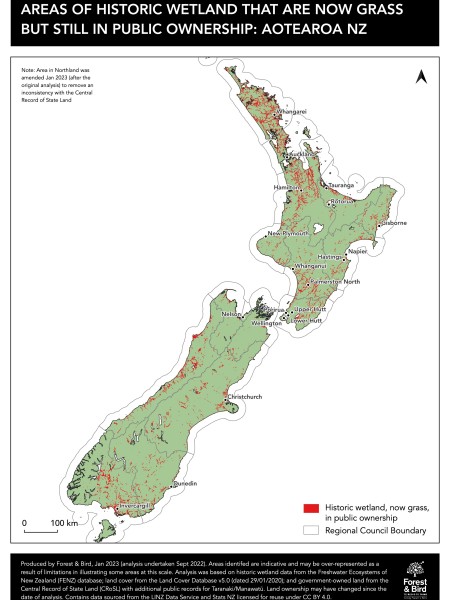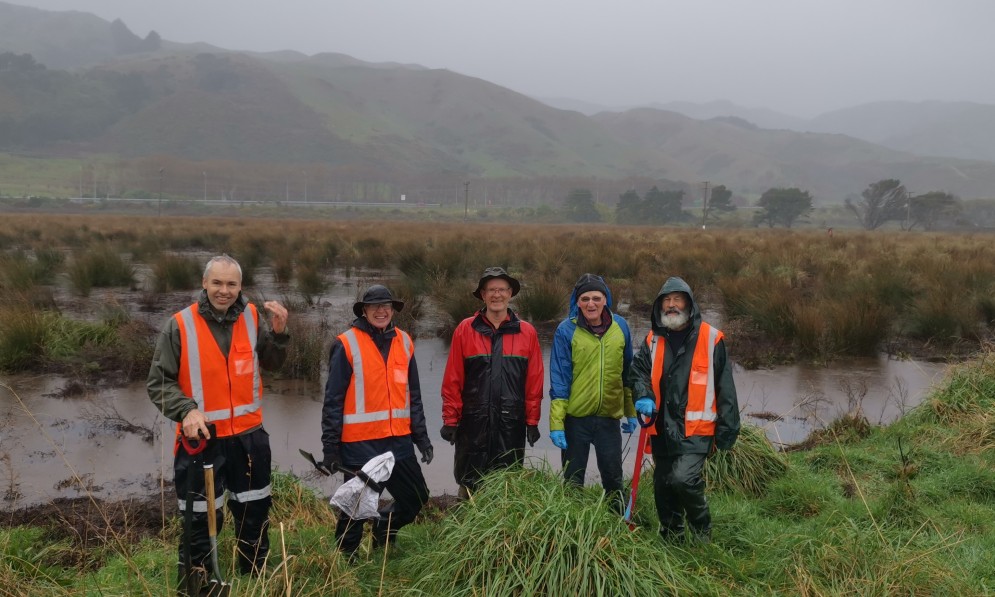Forest & Bird says a recent analysis shows around 125,000 hectares of lost wetland in public ownership could be restored, providing habitat for native species and helping to protect Aotearoa against biodiversity loss and climate change.
The announcement is based on a mapping analysis that identified areas of historic wetland – now grassed but which remain in public ownership – that could be ideal sites for restoration.
The analysis contributes to this year’s theme for World Wetlands Day (2 February), which highlights the urgent need to prioritise reviving and restoring wetlands around the globe.

Download the maps of potential wetlands for restoration on public land, wetland images (free to use with the appropriate credit) and the prediction of wetland extent before humans arrived in Aotearoa New Zealand.
Forest & Bird’s freshwater advocate, Tom Kay, says the analysis identified thousands of hectares of river and stream margins, farmland, conservation land, parks, and other areas in public ownership that could be considered for wetland restoration.
“We overlaid maps from the Central Record of State Land (CRoSL), the Land Cover Database, and predictions of historic wetlands, as well as maps from other sources,” Mr Kay says.
“What we’ve discovered is a significant amount of public land – in slivers, pockets, and larger areas – managed by the Department of Conservation, Land Information New Zealand, and Pāmu (Landcorp Farming Limited), as well as regional and district councils and other public agencies, that was historically wetland and could be again.
“These spaces have been cleared or drained and are now grassed, but there is a golden opportunity for councils and the Government to restore many back into wetland ecosystems.”
Mr Kay says identifying these potential areas for wetland restoration is one of the first steps in developing a national restoration plan and is a valuable move towards addressing the biodiversity and climate crises.
Wetland restoration would support the Government’s commitments and objectives under the Te Mana o te Taiao – Aotearoa New Zealand Biodiversity Strategy, the Emissions Reduction Plan, and the National Adaptation Plan, as well as the international Ramsar Convention on Wetlands.
“The wetland restoration projects already happening around Aotearoa show what is possible. They are a clear indicator that more and more people are recognising the value of wetlands for carbon storage, climate resilience, biodiversity, and recreation,” Mr Kay says.
“We now need Government and councils to commit to looking at these areas and refining the analysis using local data as well as insights from community groups and iwi, and then start restoring them.
“We’re aware that while some of these spaces might not be suited to restoration, others in both urban and rural areas would be ideal – we are really pleased to be able to help communities start having these conversations.”
Forest & Bird is aware of wetland restoration projects already underway in some of the areas identified in the analysis and commends the agencies leading those projects. These include:
- Greater Wellington Regional Council – Queen Elizabeth Park wetland restoration as a permanent carbon sink.
- Christchurch City Council – Te Kuru wetland restoration and stormwater basin.
- Pāmu (Landcorp Farming Limited) – Protection (through QEII covenant), fencing, and rewetting of Fred Burn wetland - Southland.
- Department of Conservation – two examples have been undertaken as part of the Department’s Arawai Kākāriki wetland restoration programme. These are:
- Awarua Wetland (Southland), including extensive planting of historic wetland between Toetoes Conservation Area and Waituna Lagoon.
- Whangamarino Wetland (Waikato), including retiring grazing concessions.
Another example of an area being restored on public land that wasn’t picked up in the analysis is Christchurch City Council's ‘red zone’ wetland restoration.
Other examples led by Forest & Bird include:
- Forest & Bird (Napier Branch) and Hawke’s Bay Regional Council’s Waitangi Regional Park wetland restoration.
- Forest & Bird (Hastings-Havelock North Branch) and Hawke’s Bay Regional Council’s restoration of the banks of the Poukawa Stream, which drains the wetlands that form Pekapeka Regional Park.
- Forest & Bird’s (Lower Hutt Branch) restoration of Waiū wetland in Wainuiomata.
“Many of the communities around these cleared, drained, and now restored wetlands are experiencing massive benefits. There’s enormous potential for more wetland restoration – we just need central and local government to resource and accelerate it.” Mr Kay says.
This year’s data analysis builds on the launch of Forest & Bird’s 2022 campaign, Every Wetland Counts – He Puipuiaki Ia Rohe Kōreporepo. The campaign has six asks of Government including to double natural wetland extent by 2050. An oral submission supporting these asks is scheduled to be presented to the Environment Committee in 2023.

